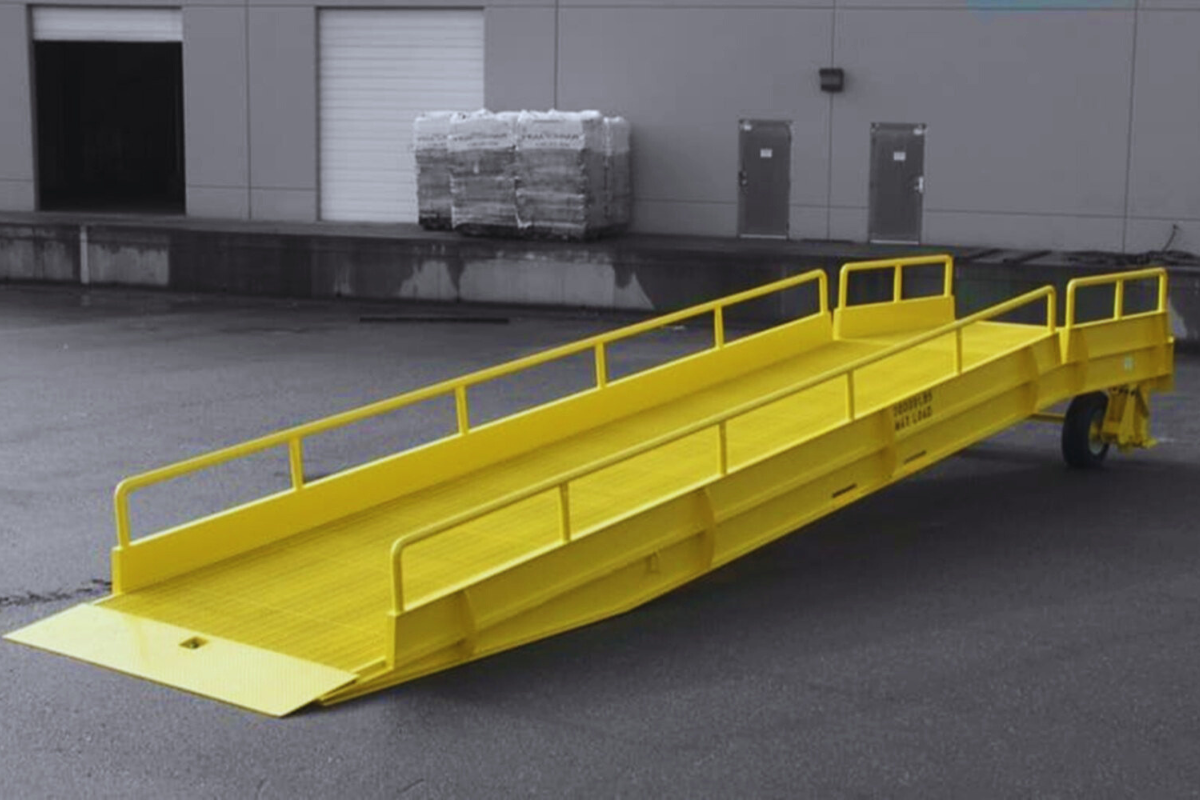Introduction
In modern warehouses, efficiency and safety are top priorities. With the increasing demand for streamlined logistics and quick turnaround times, mobile ramps have become essential tools for warehouse operations. These ramps enable seamless loading and unloading of goods, improve workflow, and enhance workplace safety. In this blog, we explore the benefits of mobile ramps in warehouses, their impact on operational efficiency, and key safety considerations.
The Role of Mobile Ramps in Warehouse Operations
Mobile ramps, also known as portable loading ramps, provide a flexible and efficient solution for material handling. Unlike fixed ramps, mobile ramps can be moved and adjusted to suit different loading and unloading areas, making them highly versatile.
1. Enhancing Loading and Unloading Efficiency
One of the primary advantages of mobile ramps is their ability to speed up the loading and unloading process. Warehouses handling high volumes of goods need quick solutions to transfer items between trucks, trailers, and storage areas. Mobile ramps facilitate smooth transitions, reducing manual effort and saving time.
Key benefits:
- Reduce wait times for trucks and delivery vehicles.
- Enable direct forklift access to trailers, reducing manual handling.
- Optimize warehouse space by creating temporary loading docks.
2. Improving Warehouse Safety
Safety is a critical concern in any warehouse setting. Accidents related to loading and unloading operations can cause injuries, equipment damage, and costly downtime. Mobile ramps play a significant role in enhancing safety by providing a stable and controlled loading platform.
Safety benefits of mobile ramps:
- Non-slip surfaces: Many mobile ramps are equipped with anti-slip textures to prevent accidents caused by wet or uneven surfaces.
- Guardrails and side curbs: Prevent forklifts and hand trucks from veering off the ramp.
- Adjustable height: Ensures proper alignment with trailers and loading docks, reducing the risk of sudden drops or misalignment.
- Load-bearing capacity: High-quality mobile ramps are designed to support heavy loads without structural failure.
3. Versatility and Adaptability
Warehouse operations require adaptability to different loading scenarios. Portable loading ramps offer flexibility as they can be moved and repositioned based on workflow demands.
Applications of mobile ramps in warehouses:
- Temporary loading docks: When permanent loading docks are unavailable or under maintenance.
- Multi-location use: Warehouses with multiple loading areas can reposition ramps as needed.
- Seasonal demand management: During peak business seasons, additional mobile ramps help meet increased logistics needs.
Types of Mobile Ramps Used in Warehouses
Mobile ramps come in different designs, each catering to specific warehouse requirements.
1. Forklift Ramps
Forklift ramps enable smooth entry and exit of forklifts from trailers and containers. These ramps are designed with reinforced materials to handle heavy machinery loads.
2. Yard Ramps
Yard ramps are portable loading solutions that allow forklifts to transport goods between ground level and trailers. They are ideal for warehouses without permanent docks.
3. Container Ramps
Container ramps provide direct access to shipping containers, making it easier to load and unload cargo with pallet jacks and forklifts.
Factors to Consider When Choosing a Mobile Ramp
Selecting the right mobile ramp is crucial for optimizing warehouse efficiency and ensuring safety. Here are key factors to consider:
1. Weight Capacity
The ramp should be able to support the combined weight of the forklift and the load it carries. Always check the manufacturer’s specifications before purchasing.
2. Ramp Material
Common materials include steel and aluminum. Steel ramps offer higher durability and weight capacity, while aluminum ramps are lighter and easier to move.
3. Surface Traction
Anti-slip coatings and grated surfaces enhance traction, preventing slippage during wet or icy conditions.
4. Mobility and Adjustability
Look for ramps with wheels and height-adjustable features to accommodate different loading conditions.
5. Compliance with Safety Standards
Ensure the ramp meets OSHA (Occupational Safety and Health Administration) and ANSI (American National Standards Institute) safety regulations.
Best Practices for Using Mobile Ramps in Warehouses
To maximize the benefits of mobile ramps, warehouse managers should follow these best practices:
1. Conduct Regular Inspections
Check for wear and tear, structural integrity, and surface conditions to prevent accidents.
2. Train Employees on Proper Usage
Provide training on the correct positioning, weight limits, and safe handling of mobile ramps.
3. Secure the Ramp Before Use
Ensure the ramp is firmly in place and properly aligned with loading surfaces before operation.
4. Avoid Overloading
Exceeding the ramp’s weight capacity can lead to structural failure and safety hazards.
5. Implement a Maintenance Schedule
Routine maintenance, such as cleaning debris and checking for rust or damage, extends the lifespan of mobile ramps.
Conclusion
Mobile ramps are indispensable tools in warehouse operations, providing efficiency, flexibility, and enhanced safety. By investing in high-quality warehouse loading ramps, businesses can streamline their logistics processes, reduce labor costs, and minimize workplace accidents.
Choosing the right ramp, adhering to safety protocols, and maintaining regular inspections will ensure that warehouse operations run smoothly. As technology advances, mobile ramps will continue to evolve, offering even more innovative solutions for material handling.
Are you looking for the best mobile ramps for your warehouse? Explore our range of high-performance loading ramps designed for durability and efficiency.


